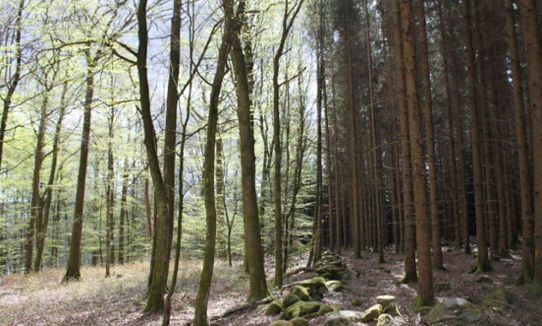Forestry and climate change
The challenges that forestry is facing as a result of climate and climate change include fires, greater risk of drought, and the risk of root rot, storm felling and damage from spruce bark beetles and other pests. Forest harvesting also entails an elevated risk of landslides and avalanches. Today, the Swedish forest is mainly used with clear-cut forestry and is dominated by pine and spruce plantings. Together with overgrowth, these are the factors that affect the most red-listed species in Sweden. The Swedish Forest Agency identifies several risks, and one measure that is mentioned is working for greater variety of tree species and the right tree species at the right place in the Swedish forests.
The Lübeck model and climate adaptation
The Lübeck model is an ecosystem-based forestry method that strives for the cultivated forest to be as similar to a natural forest as possible. This is done by working based on the natural type of forest for the location. The forest is managed so that it is permitted to grow and adapt to the prevailing soil and climate conditions. Thinning is done to some extent with the Lübeck model and the trees are harvested through selective felling instead of clear-cutting. This way, the forest may continuously remain without involving extensive planting, soil preparation or clearing. Forestry in varied forests also means that the risks are spread. This constitutes the most important difference from clear-cut forestry.

In a forest managed with the Lübeck model, there are full-grown trees over the entire property, which protects the forest species. The trees are also allowed to become larger in contrast to clear-cut forestry. Thanks to the forest always remaining, the risk is reduced of landslides and avalanches in connection with strong precipitation. In a warmer climate, a larger share of deciduous trees would reduce the risk of the spread of fire as the deciduous trees’ crowns are not as easily lit as conifers. Moreover, mixed forest is more resistant to the root fungus that easily leads to root rot. The larger share of deciduous trees, the less the likelihood of storm felling. A naturally growing mixed forest with trees of various ages is more resistant to pests, such as the spruce bark beetle. The types of trees permitted to grow in their natural locations have better conditions of managing drought and precipitation.
Altogether, the Lübeck model is a forestry method with naturally growing trees of various ages that takes consideration of biological diversity. At the same time, the method reduces the risks that the current and future climate entails for forestry.
There are examples that indicate that the Lübeck model is profitable on the long term with regard to finances, value of the supply, and preservation of biodiversity.
Challenges
The work differs widely between an ecosystem-based forestry, such as the Lübeck model, and clear-cut forestry, which means that partly different knowledge is needed than before.
More examples of climate adaptation
This is one of many examples of climate adaptation. There are more in the collection of ideas being built up by the Swedish National Knowledge Centre for Climate Change Adaptation at the Swedish Meteorological and Hydrological Institute (SMHI). The collection of examples has the aim of sharing experiences and providing ideas to everyone who works with climate adaptation. Examples describe concrete measures and challenges in several subject areas. They show how different actors have worked to adapt their activities to the climate changes that are already being noticed today and those that we cannot prevent in the future.